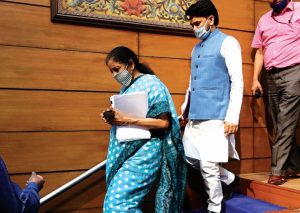 The pitch for “Atamnirbhar Bharat Abhiyan” or self-reliant India to open up the economy is timely. The Prime Minister, Narendra Modi has announced a `20 lakh crore stimulus package equivalent to 10 per cent of Gross Domestic Product. The challenge is two-fold reviving the economy and supporting the vulnerable sections. Also the twin challenges is choosing between life and livelihood. The prime minister has added a new slogan, ‘Be vocal about local’. It is inspirational and aspirational.
The pitch for “Atamnirbhar Bharat Abhiyan” or self-reliant India to open up the economy is timely. The Prime Minister, Narendra Modi has announced a `20 lakh crore stimulus package equivalent to 10 per cent of Gross Domestic Product. The challenge is two-fold reviving the economy and supporting the vulnerable sections. Also the twin challenges is choosing between life and livelihood. The prime minister has added a new slogan, ‘Be vocal about local’. It is inspirational and aspirational.
However, the big question remains. Will the mega stimulus infuse life into the weathered business and industry? Are the tranche of package announced enough to soothe frayed nerves? The strong pitch for local products or self-reliance is timely as pandemic has accentuated problems for economy. It is a harsh reality that the “Make in India” slogan has not met with much success.
In this story, Tehelka analyses whether the booster package will prove to be a survival kit for the businesses and industry and bring back jobs to provide succor to migrant workers and other unemployed while reviving the economy.
Revival package
Let us first talk about the revival package. The prime minister, Narendra Modi has announced a special economic and comprehensive package of `20 lakh crore-equivalent to 10 per cent of India’s GDP. He also gave a call for “Atamnirbhar Bharat Abhiyan” or self reliant India movement outlining its five pillars — Economy, Infrastructure, System, Vibrant, Demography and Demand.
It was left for the Union Finance & Corporate Affairs Minister Nirmala Sitharaman to explain the structural reforms and at her very first interaction with media, she emphasized that many sectors need policy simplification, to make it simpler for people to understand what sector can give, participate in activities and bring transparency. She observed that once we decongest the sectors, we can boost the sector, for growth.
The Finance Minister said that Prime Minister has very strong record in taking up deep systemic reforms citing Direct Benefit Transfer enabled giving money directly to people, GST brought in One Nation, One Market, Insolvency and Bankruptcy Code (IBC) resolved insolvency issues and steps taken for Ease of Doing Business.
She outlined the need for Policy reforms to fast track investments and the steps taken by the Government in this regard and stated that fast track clearance will be done through Empowered Group of Secretaries. A Project Development Cell would be set up in each Ministry to prepare investable projects and coordinate with investors and Central and State governments.
Policy reforms
The Finance Minister announced series of policy reforms to fast track investment in an effort towards a self-reliant India. There will be fast tracking of investment clearance through Empowered Group of Secretaries.
The Project Development Cell will be constituted in each Ministry to prepare investible projects, coordinate with investors and Central and State Governments. There will be ranking of States on investment attractiveness to compete for new investment. Incentive schemes for promotion of new champion sectors will be launched in sectors such as solar PV manufacturing; advanced cell battery storage etc.
 Sitharaman observed that a scheme will be implemented in States through challenge mode for Industrial Cluster Upgradation of common infrastructure facilities and connectivity. There will be availability of industrial land and land banks for promoting new investments and making information available on Industrial Information System (IIS) with GIS mapping. About 3376 Industrial Parks, Estates and SEZs in five lakh hectares are mapped on IIS. All Industrial Parks will be ranked during 2020-21.
Sitharaman observed that a scheme will be implemented in States through challenge mode for Industrial Cluster Upgradation of common infrastructure facilities and connectivity. There will be availability of industrial land and land banks for promoting new investments and making information available on Industrial Information System (IIS) with GIS mapping. About 3376 Industrial Parks, Estates and SEZs in five lakh hectares are mapped on IIS. All Industrial Parks will be ranked during 2020-21.
Major agriculture reforms
However, what is most important reforms is perhaps the Centre’s decision to amend the Essential Commodities Act as a major reform for Indian agriculture.
The marketing reform, announced by the Finance Minister as part of the third tranche of the stimulus package, aims to deregulate cereals, edible oil, oilseeds, pulses, onion and potato.
It will allow processors, millers, exporters and traders to hold as much stock of these commodities as they want to. To remove barriers to inter-state trade, a new legislatoion is proposed to not bind farmers to sell their crop only to licensed traders in their district. The farmers will be able to sell to anyone and anywhere, and traders can freely buy, stock and move any quantity of agri-produce within the country.
Eight key sectors
The eight key sectors chosen for structural reforms are coal, minerals, defence production, civil aviation, power sector, social infrastructure, space and atomic energy.
The coal sector will see introduction of commercial mining. The Government will introduce competition, transparency and private sector participation in the Coal Sector through a revenue sharing mechanism instead of regime of fixed Rupee/tonne. Any party can bid for a coal block and sell in the open market. Entry norms will be liberalized. Nearly 50 Blocks will be offered immediately. There will not be any eligibility conditions, only upfront payment with a ceiling will be provided.
In coal sector, there will be exploration-cum-production regime for partially explored blocks against earlier provision of auction of fully explored coal blocks. This will allow private sector participation in exploration. Production earlier than scheduled will be incentivized through rebate in revenue-share.
There will be diversified opportunities in coal sector. Coal Gasification and Liquefication will be incentivized through rebate in revenue share. This will result in significantly lower environment impact and also assist India in switching to a gas-based economy. Infrastructure development of `50,000 crore will be done for evacuation of enhanced Coal India Limited’s (CIL) target of 1 billion tons coal production by 2023-24 plus coal production from private blocks. This will include `18,000 crore worth of investment in mechanized transfer of coal (conveyor belts) from mines to railway sidings.
This measure will also help reduce environmental impact.
For liberalized regime in coal sector, the Coal Bed Methane (CBM) extraction rights will be auctioned from Coal India Limited’s (CIL) coal mines. Ease of Doing Business measures, such as Mining Plan simplification, will be taken.
This will allow for automatic 40 per cent increase in annual production.
Concessions in commercial terms given to CIL’s consumers (relief worth `5,000 crore offered). Reserve price in auctions for non-power consumers reduced, credit terms eased, and lifting period has been enhanced.
There would be an emphasis on enhancing private investment in mineral sector. There will be structural reforms to boost growth, employment and bring state-of-the-art technology especially in exploration through introduction of a seamless composite exploration-cum-mining-cum-production regime.
About 500 mining blocks would be offered through an open and transparent auction process. Joint Auction of Bauxite and Coal mineral blocks to enhance Aluminum Industry’s competitiveness will be introduced to help Aluminum industry reduce electricity costs.
The distinction between captive and non-captive mines to allow transfer of mining leases and sale of surplus unused minerals, leading to better efficiency in mining and production shall be removed. Ministry of Mines is in the process of developing a Mineral Index for different minerals. There will be rationalization of stamp duty payable at the time of award of mining leases.
The “Make in India” for self-reliance in defence production would be promoted by notifying a list of weapons and platforms for ban on import with year wise timelines, Indigenization of imported spares, and separate budget provisioning for domestic capital procurement.
This will help reduce huge Defence import bill. Steps will be taken to improve autonomy, accountability and efficiency in Ordnance Supplies by Corporatisation of Ordnance Factory Board.
The policy reforms in defence production would entail raising the FDI limit in the defence manufacturing under automatic route raised from 49 per cent to 74 per cent.
There will be time-bound defence procurement process and faster decision making will be ushered in by setting up of a Project Management Unit (PMU) to support contract management; Realistic setting of General Staff Qualitative Requirements (GSQRs) of weapons and platforms and overhauling Trial and Testing procedures.
In civil aviation sector to bring about efficient airspace management for civil aviation, the restrictions on utilization of the Indian Air Space will be eased so that civilian flying becomes more efficient. This will bring a total benefit of about `1,000 crore per year for the aviation sector. This will lead to optimal utilization of airspace; reduction in fuel use, time and will have positive environmental impact.
There will be more world-class airports through public-private partnership basis.
As many as six more airports have been identified for second round bidding for Operation and Maintenance on Public-Private Partnership (PPP) basis.
Additional Investment by private players in 12 airports in 1st and 2nd rounds is expected to bring around `13,000 crore. Another six airports will be put out for the third round of bidding.
India would strive to become a global hub for aircraft maintenance, repair and overhaul (MRO). Tax regime for MRO ecosystem has been rationalized.
Aircraft component repairs and airframe maintenance to increase from `800 crore to `2,000 crore in three years. It is expected that major engine manufacturers in the world would set up engine repair facilities in India in the coming year. Convergence between Defence sector and the civil MROs will be established to create economies of scale. This will lead to maintenance cost of airlines to come down.
Tariff policy reforms in the power sector are on the anvil. These include consumer rights. The DISCOM inefficiencies not to burden consumers and there would be standards of Service and associated penalties for DISCOMs. At the same time, the DISCOMs to ensure adequate power; load-shedding to be penalized.
There will be progressive reduction in cross subsidies and time bound grant of open access. The generation and transmission project developers to be selected competitively in future. To achieve sustainability of power sector, there will be no regulatory assets, there will be timely payment of Gencos and DBT for subsidy; Smart prepaid meters.
Power Departments and Utilities in Union Territories will be privatized. This will lead to better service to consumers and improvement in operational and financial efficiency in Distribution. This will also provide a model for emulation by other Utilities across the country.
To give a boost to social infrastructure, the Government will enhance the quantum of Viability Gap Funding (VGF) upto 30 per cent each of Total Project Cost as VGF by the Centre and State and Statutory Bodies. For other sectors, VGF existing support of 20 per cent each from Government of India and States and Statutory Bodies shall continue. Total outlay is Rs. 8,100 crore. Projects shall be proposed by Central Ministries/ State Government/ Statutory entities.
For space sector, there shall be level playing field provided to private companies in satellites, launches and space-based services. Predictable policy and regulatory environment to private players will be provided.
Private sector will be allowed to use ISRO facilities and other relevant assets to improve their capacities. Future projects for planetary exploration, outer space travel etc shall also be open for private sector. There will be liberal geo-spatial data policy for providing remote-sensing data to tech-entrepreneurs.
Under the atomic energy related reforms, research reactor in PPP mode for production of medical isotopes shall be established to promote welfare of humanity through affordable treatment for cancer and other diseases. Facilities in PPP mode to use irradiation technology for food preservation — to compliment agricultural reforms and assist farmers shall also be established.
India’s robust start-up ecosystem will be linked to nuclear sector and for this, Technology Development-cum-Incubation Centres will be set up for fostering synergy between research facilities and tech-entrepreneurs.
Not `20L crore, it’s `20.97 L crore
The subsequent tranches of stimulus announced by the Finance Minister Nirmala Sitharaman add upto `20,97,053 crore, which includes `1.92 lakh crore stimulus from measures announced by the PM recently such as the Pradhan Matri Garib Kalyan Package worth `1.7 lakh crore.
A big chunk, in fact the largest, worth `8.01 lakh crore of the economic package belonged to the various measures by the Reserve Bank of India in February, March and April this year to inject liquidity.
First tranche — 5,94,550 crore
The first set of relief measures announced by the Finance Minister focused on enabling the Indian economy’s backbone, the MSME sector that employ around 11 crore people and have a GDP share of approximately 29 per cent.
To boost liquidity, `3 lakh crore collateral-free loans and `50,000 crore equity infusion for MSMEs through Fund of Funds has been announced.
Liquidity relief measures worth `30,000 crore were also announced for NBFCs, HFCs etc. and `90,000 crore for power distribution companies.
Second tranche — 3,10,000 crore
The second tranche of measures related to migrant workers, the most vulnerable section of society. A ‘one nation one ration card’ has been planned to allow migrant workers to buy ration from any depot in the country while a credit facility of `5,000 crore was announced to support around 50 lakh street vendors who will have access to an initial `10,000 working capital. About `2 lakh crore will be given to farmers through Kisan credit cards while 2.5 crore farmers, including fishermen and animal husbandry farmers, would be able to get institutional credit at a concessional rate. The government allowed states to fund the food and shelter facilities to migrant workers from the disaster response fund that would cost `11,000 crore to the centre.
Third tranche – 1,50,000 crore
The third tranche of the measures worth `1.5 lakh crore focused on the agriculture and allied sectors including dairy, animal husbandry and fisheries as the government announced steps to strengthen the overall farm sector. The finance minister announced `1 lakh crore agriculture infrastructure fund for farm-gate infrastructure including using it for setting up cold chains and post-harvest management infrastructure.
Other key announcements made by the minister included `20,000 to be provided to fishermen through Pradhan Mantri Matsya Sampada Yojana, and `10,000 crore to formalize micro food enterprises.
“This will be a cluster-based approach, with which, local value-added products can reach global markets,” the minister had said. `4,000 crore for herbal cultivation, a `15,000 crore Animal Husbandry Infrastructure Development Fund, `500 crore for bee-keeping related infrastructure development were other packages announced by the minister.
Tranches 4 &5 — 48,100 crore
The fourth installment of the `20 lakh crore package comprised of reforms for sectors including coal, minerals, defence production, air space management, airports, MRO, distribution companies in UTs, space sector, and atomic energy.
She has allocated an additional `40,000 crore for the Mahatma Gandhi National Rural Employment Guarantee Act (MGNREGA) for job creation in India’s hinterland. The government had earlier allocated `61,000 crore in the budget for this financial year.
Questioning the 20L crore package
Former Finance Minister, P Chidambaram questioned the mega stimulus touted to be of over `20 lakh crore announced through five tranches.
He said that in his considered opinion, only a few items that qualify as Fiscal Stimulus Measures entailing Additional Expenditure over and above the amount of `30,42,230 crore in the Expenditure Budget for 2020-21.
This includes revenue lost due to tax concessions since 22-03-2020 of `7,500 crore, Pradhan Mantri Garib Kalyan Package of cash transfers of `33,000 crores, free grain of `60,000 crore, Medical and Health Infrastructure of `15,000 crore, EPF support for Businesses and workers of `2,800 crore, reduction of EPF rates about `6,750 crore, free food grain for migrant workers for two months of `3,500 crore, interest subsidy for MUDRA Shishu loans (assuming the entire subsidy will be paid to the banks in 2020-21) of `1,500 crore, additional credit through KCC (assuming the additional interest subsidy will be paid to the lenders in 2020-21) of ` 8,000 crore, Operation Greens `500 crore, Promotion of Herbal cultivation for two years `4,000 crore.
 He clarified that this figure was meant for two years of which `700 crore has already been provided for in 2020-21 Budget, so we it has not been included it in the calculation. There is Viability Gap Funding (assuming the entire amount will be paid in 2020-21) of `8,100 crore. The additional allocation for MGNREGS is ` 40,000 crore.
He clarified that this figure was meant for two years of which `700 crore has already been provided for in 2020-21 Budget, so we it has not been included it in the calculation. There is Viability Gap Funding (assuming the entire amount will be paid in 2020-21) of `8,100 crore. The additional allocation for MGNREGS is ` 40,000 crore.
According to former FM, the total comes to `1,86,650 crore and rest of the announcements are included already in the budgeted expenditure, front loading of some budgeted expenditure, regulatory measures, a number of liquidity measures, medium to long term plans and schemes, and proposed reforms.
He said that “there can be no fiscal stimulus to the economy without Additional Expenditure over and above the Budgeted Expenditure”.
He said that the “truth cannot be hidden for long” and went on to say that a fiscal stimulus of `1,86,650 crore amounting to barely 0.91 per cent of GDP will be totally inadequate given the gravity of the economic crisis and the dire situation in which people find themselves. Most analysts, rating agencies and banks have placed the size of the fiscal stimulus at between 0.8 to 1.5 per cent.












